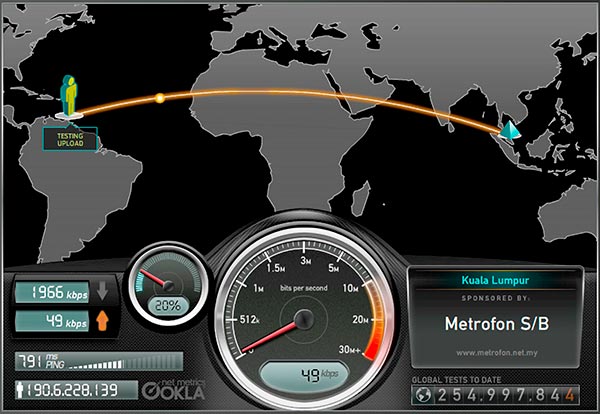BitDepth 608 - December 25
07/01/09 19:27 Filed in: BitDepth - December 2007
Accurately measuring your actual broadband capacity is key to maximising your new high speed Internet connection.
Why 15 megabits isn't always fast

Speedtest.net offers an attractive interface and global options for testing connection speeds. Dig a bit deeper on the site and you can find out just how fast your connection is from different parts of Trinidad and Tobago to other servers around the world.
Both TSTT and Flow offer premium broadband services with connection rates in excess of ten megabits for downloads in roughly comparable prices just shy of TT$700.
Here's why you may not want to buy their premium package.
There are two aspects to high-speed Internet use that you will have to wrap your head around, one is the real world speed of networks and the other is understanding just what a megabit is.
Because transmission speeds are not measured the same way as capacity is, the differences between Internet speeds and file sizes (both of which are unhelpfully truncated to mb's and kb's) can easily become confused.
Here's the key: there are eight bits = one byte.
It takes eight kilobits to make a kilobyte, so when you shop for Internet speeds, you'll need to divide by eight to have a sense of just how fast files will actually be transferred. A two megabit connection, for instance, transfers files at a theoretical 250 kilobytes per second, not at two megabytes per second.
Serving bits, bytes at a time
When it comes to real world experiences with web connections, Internet service is kind of like going to a fast food restaurant. When you arrive, you're hungry and want to be served right away. The restaurant, meanwhile, has a process it has to work through to get that food to you, particularly if it isn't a popular choice.
This can lead to some conflicts. Flow, which was first off the blocks with a truly high-speed Internet service, has apparently been having some issues with their customers because of it.
Internet speeds in a perfect world would be just what's promised on the box (or website). You click on a download and 10-15 megabits per second later, the file is on your computer.
But the Internet isn't designed for such perfection; it's designed for redundancy. Every data packet that's part of your download can travel through multiple routes passing through uncounted servers on the path between where it's stored and your system. Each of those paths will have its own cap on speeds and the server from which it originates from may also have limits on the speed it will allow for each download session.
These restraints exist because the Internet isn't as free as we like to think it is. Anyone offering a file has to pay for access to it and popular download sites don't want costs to run away from them.
 Filling the Internet pipe
Filling the Internet pipe
So-called "download managers" use software voodoo to issue multiple requests to a single server for a file, each of which registers as a single download and then reassembles the packets from those streams at your computer. Good download managers can triple the speeds of an average download, but some download sites don't like them and try to stymie people who use them.
BitTorrent is a special protocol for downloading that can maximise a large data connection. When you launch the software, you see a window with your search results and click to download just as if it were a normal web download session.
The difference with torrents is that once you begin to download, you also begin to upload, or seed that data to other downloaders.
A popular torrent can have hundreds of seeders originating all around the world, which can provide enough data to saturate a high-speed data connection. Conversely, an unpopular torrent with just a couple of seeds can be as slow as a dial-up connection (from which it might actually be seeded).
Some commercial sites like Apple's collection of movie trailers and download sites that offer updates for hardware can be very fast by design but most will peak at around one to two megabits per second for now.
Some sophisticated users can make use of more direct connections with colleagues who are close to an Internet backbone either by design or by fluke, but most average web users will get the biggest bang for our access buck with a two megabit package.
What's your broadband experience?
I've been getting some interesting e-mails from new broadband customers about their experiences with Flow and TSTT. What has your experience been? If there have been problems, details on what happened would be useful in getting a picture of what's actually happening on the ground as broadband is rolled out nationwide.
Common tactics for maximising Internet use...
Use FTP with an FTP client when downloads are offered using that protocol. You can create multiple downloads using this download method with greater efficiency than regular browser based (http) downloads.
Increase the number of concurrent download sessions in your browser. Most browsers are set to limit download sessions to three or four downloads. With a fast connection, that's an artificial limit.
Disable your web browser's cache. It will take longer for your browser to search the cache, compare it with what's on the site and load the page than it will to just load the page on a fast connection.

Speedtest.net offers an attractive interface and global options for testing connection speeds. Dig a bit deeper on the site and you can find out just how fast your connection is from different parts of Trinidad and Tobago to other servers around the world.
Both TSTT and Flow offer premium broadband services with connection rates in excess of ten megabits for downloads in roughly comparable prices just shy of TT$700.
Here's why you may not want to buy their premium package.
There are two aspects to high-speed Internet use that you will have to wrap your head around, one is the real world speed of networks and the other is understanding just what a megabit is.
Because transmission speeds are not measured the same way as capacity is, the differences between Internet speeds and file sizes (both of which are unhelpfully truncated to mb's and kb's) can easily become confused.
Here's the key: there are eight bits = one byte.
It takes eight kilobits to make a kilobyte, so when you shop for Internet speeds, you'll need to divide by eight to have a sense of just how fast files will actually be transferred. A two megabit connection, for instance, transfers files at a theoretical 250 kilobytes per second, not at two megabytes per second.
Serving bits, bytes at a time
When it comes to real world experiences with web connections, Internet service is kind of like going to a fast food restaurant. When you arrive, you're hungry and want to be served right away. The restaurant, meanwhile, has a process it has to work through to get that food to you, particularly if it isn't a popular choice.
This can lead to some conflicts. Flow, which was first off the blocks with a truly high-speed Internet service, has apparently been having some issues with their customers because of it.
Internet speeds in a perfect world would be just what's promised on the box (or website). You click on a download and 10-15 megabits per second later, the file is on your computer.
But the Internet isn't designed for such perfection; it's designed for redundancy. Every data packet that's part of your download can travel through multiple routes passing through uncounted servers on the path between where it's stored and your system. Each of those paths will have its own cap on speeds and the server from which it originates from may also have limits on the speed it will allow for each download session.
These restraints exist because the Internet isn't as free as we like to think it is. Anyone offering a file has to pay for access to it and popular download sites don't want costs to run away from them.

So-called "download managers" use software voodoo to issue multiple requests to a single server for a file, each of which registers as a single download and then reassembles the packets from those streams at your computer. Good download managers can triple the speeds of an average download, but some download sites don't like them and try to stymie people who use them.
BitTorrent is a special protocol for downloading that can maximise a large data connection. When you launch the software, you see a window with your search results and click to download just as if it were a normal web download session.
The difference with torrents is that once you begin to download, you also begin to upload, or seed that data to other downloaders.
A popular torrent can have hundreds of seeders originating all around the world, which can provide enough data to saturate a high-speed data connection. Conversely, an unpopular torrent with just a couple of seeds can be as slow as a dial-up connection (from which it might actually be seeded).
Some commercial sites like Apple's collection of movie trailers and download sites that offer updates for hardware can be very fast by design but most will peak at around one to two megabits per second for now.
Some sophisticated users can make use of more direct connections with colleagues who are close to an Internet backbone either by design or by fluke, but most average web users will get the biggest bang for our access buck with a two megabit package.
What's your broadband experience?
I've been getting some interesting e-mails from new broadband customers about their experiences with Flow and TSTT. What has your experience been? If there have been problems, details on what happened would be useful in getting a picture of what's actually happening on the ground as broadband is rolled out nationwide.
Common tactics for maximising Internet use...
Use FTP with an FTP client when downloads are offered using that protocol. You can create multiple downloads using this download method with greater efficiency than regular browser based (http) downloads.
Increase the number of concurrent download sessions in your browser. Most browsers are set to limit download sessions to three or four downloads. With a fast connection, that's an artificial limit.
Disable your web browser's cache. It will take longer for your browser to search the cache, compare it with what's on the site and load the page than it will to just load the page on a fast connection.
blog comments powered by Disqus

